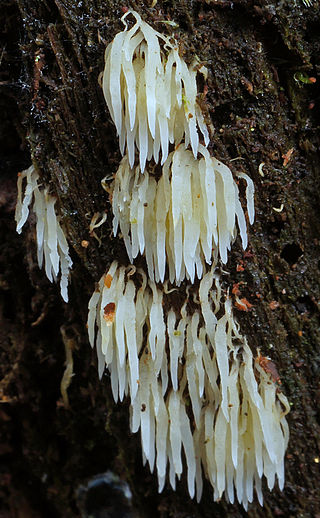
Climacodon septentrionalis, commonly known as the northern tooth fungus or the white rot fungus, is a species of shelf fungus in the phylum Basidiomycota. It is white in color and can be found in large clusters on the trunks of trees. This species is a plant pathogen native to North America.

Hydnellum is a genus of tooth fungi in the family Bankeraceae. Widely distributed in the Northern Hemisphere, the genus contains around 40 species. The fruitbodies of its members grow by slowly enveloping nearby bits of grass and vegetation. There is great variability in the form of Hydnellum fruitbodies, which are greatly influenced by environmental conditions such as rainfall and humidity, drying winds, and temperature. They are too tough and woody to eat comfortably. Several species have become the focus of increasing conservation concern following widespread declines in abundance.

The Meruliaceae are a family of fungi in the order Polyporales. According to a 2008 estimate, the family contains 47 genera and 420 species. As of April 2018, Index Fungorum accepts 645 species in the family.

The Phanerochaetaceae are a family of mostly crust fungi in the order Polyporales.

The Steccherinaceae are a family of about 200 species of fungi in the order Polyporales. It includes crust-like, toothed, and poroid species that cause a white rot in dead wood.

Postia is a genus of brown rot fungi in the family Fomitopsidaceae.

Phellodon is a genus of tooth fungi in the family Bankeraceae. Species have small- to medium-sized fruitbodies with white spines on the underside from which spores are released. All Phellodon have a short stalk or stipe, and so the genus falls into the group known as stipitate hydnoid fungi. The tough and leathery flesh usually has a pleasant, fragrant odor, and develops a cork-like texture when dry. Neighboring fruitbodies can fuse, sometimes producing large mats of joined caps. Phellodon species produce a white spore print, while the individual spores are roughly spherical to ellipsoid in shape, with spiny surfaces.

Mycorrhaphium is a genus of fungi in the family Steccherinaceae. The genus was circumscribed by Dutch mycologist Rudolph Arnold Maas Geesteranus in 1962. The type species is Mycorrhaphium adustum. Fruit bodies of species in the genus have caps, stipes, and a hydnoid (tooth-like) hymenophore. There is a dimitic hyphal system, where the skeletal hyphae are found only in the tissue of the "teeth", and a lack of cystidia. The spores are smooth, hyaline (translucent), and inamyloid.

Steccherinum is a widely distributed genus of toothed crust fungi in the family Steccherinaceae.

Mucronella is a genus of fungi in the family Clavariaceae. Species in the genus resemble awl-shaped teeth that grow in groups without a common subiculum.

The hydnoid fungi are a group of fungi in the Basidiomycota with basidiocarps producing spores on pendant, tooth-like or spine-like projections. They are colloquially called tooth fungi. Originally such fungi were referred to the genus Hydnum, but it is now known that not all hydnoid species are closely related.

Hydnellum fuscoindicum, commonly known as the violet hedgehog, is a species of tooth fungus in the genus Hydnellum. It is found in the Pacific Northwest in moss around western hemlocks. It produces fruit bodies with a violet-black cap, violet flesh, and violet spines on the cap underside. The odor and taste are very farinaceous. The fungus was first described by Kenneth A. Harrison in 1964 as a species of Hydnum, then transferred to Sarcodon in 1967 by Rudolph Arnold Maas Geesteranus. He placed this species in section Violacei of Sarcodon, along with H. fuligineoviolaceum and H. joeides.

Hydnellum scrobiculatum, commonly known as the ridged tooth or rough hydnellum, is a tooth fungus in the family Bankeraceae. Widely distributed in the Northern Hemisphere, it is found in Asia, Europe, and North America.
Phellodon plicatus is a species of tooth fungus in the family Bankeraceae. Found in Australia, it was first described in 1925 by Curtis Gates Lloyd as a species of Hydnum. Dutch mycologist Rudolph Arnold Maas Geesteranus transferred it to the genus Phellodon in 1966.
Phellodon maliensis is a species of tooth fungus in the family Bankeraceae. Found in Australia, it was originally described as a new species by Curtis Gates Lloyd in 1923. It was originally placed in Hydnum, until Dutch mycologist Rudolph Arnold Maas Geesteranus transferred it to the genus Phellodon in 1966.

Hydnellum fuligineoviolaceum is a species of tooth fungus in the family Bankeraceae. It was originally described in 1874 by Hungarian mycologist Károly Kalchbrenner as Hydnum fuligineoviolaceum, in Elias Fries's work Hymenomycetes europaei. Narcisse Théophile Patouillard transferred it to the genus Sarcodon in 1900. Sarcodon talpa, published by Rudolph Arnold Maas Geesteranus in 1967, is a synonym.
Sarcodon bubalinus is a European species of tooth fungus in the family Bankeraceae. First described by Christian Hendrik Persoon in 1825 as Hydnum bubalinum, it was transferred to the genus Sarcodon by Rudolph Arnold Maas Geesteranus in 1956.

Hydnellum martioflavum is a species of tooth fungus in the family Bankeraceae, found in Europe and North America.

Sarcodon thwaitesii is a species of tooth fungus in the family Bankeraceae. It is found in Asia, Europe, and New Zealand, where it fruits on the ground in mixed forest.
Climacodon sanguineus is a rare species of tooth fungus in the family Phanerochaetaceae that is found in Africa.















